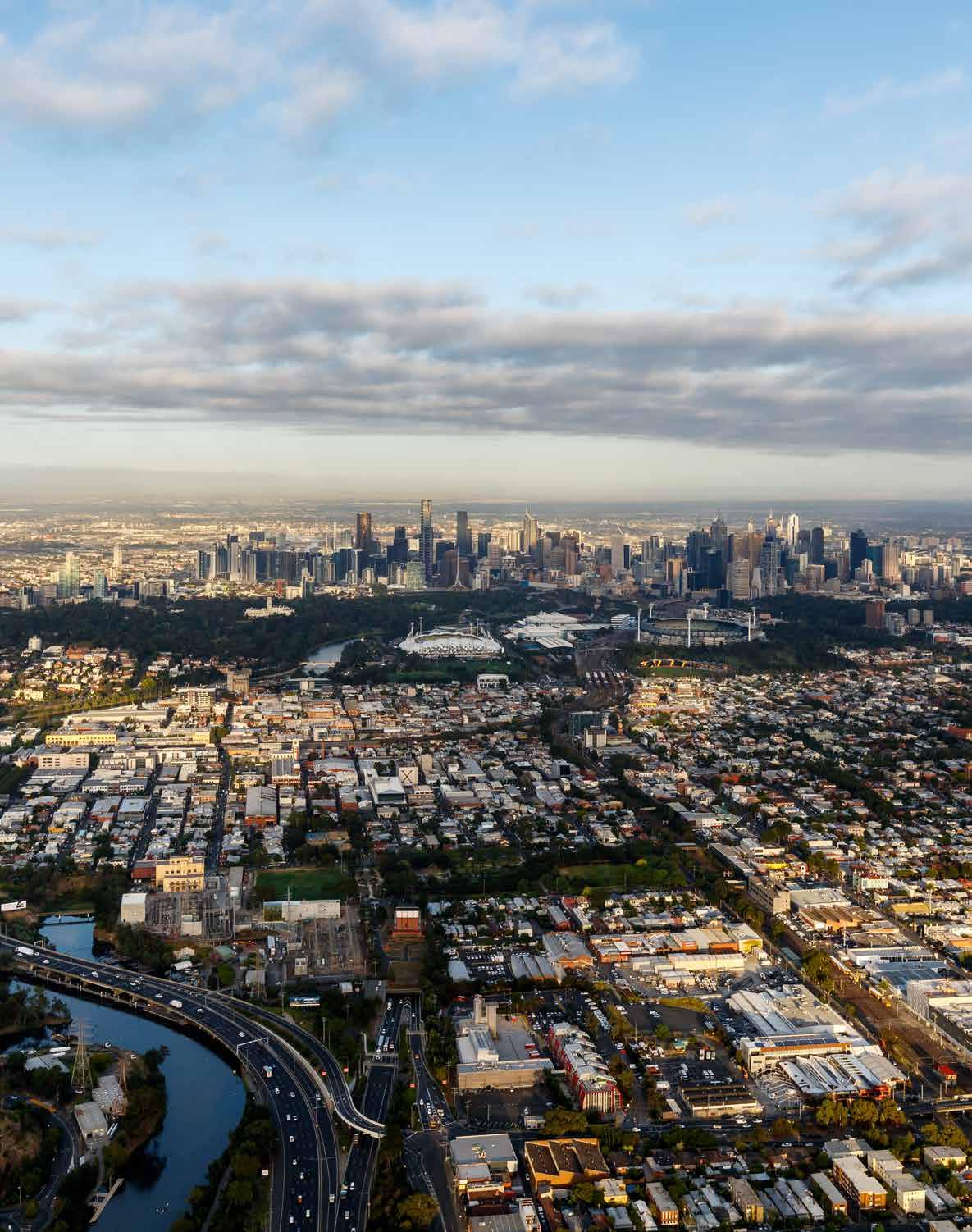Urban IQ Economic and Residential Market



• Economic growth remains subdued, with annual GDP at just 1.34%
• Inflation continues to ease, but global tariff risks may impact the pace of rate cuts
• Real wages are rising, lifting consumer confidence and savings
• Housing supply remains limited due to ongoing structural challenges basis, inflation now sits at 2.1%, its lowest level since Q1 2021 and comfortably within the RBA’s 2-3% target range.
Economic activity entered 2025 with subdued momentum. GDP grew just 0.21% over Q2 2025, bringing the annual growth to 1.34%, which is well below the long term average of 3.3%.
Household spending was one of the few positives. Both essentials and discretionary categories contributed to growth, suggesting the real wage gains are starting to lift confidence. Public investment, however, pulled back. Major projects across energy, transport, health and education have either wrapped up or hit delays, leading to a slowdown in government-led activity.
Inflation continues to ease. The CPI rose 0.7% over the quarter, lower than the revised 0.9% rise of the previous quarter. On an annual
The downward trend may not be smooth, however. Rising global tariff tensions pose a risk. Tariffs increase the cost of goods, and if inflation flares up again, the RBA could ease the speed of rate cuts. But if households and businesses begin reining back, deflationary pressures may return, prompting the RBA to move faster on easing.
Real wages continue to improve. In Q1, wages rose 0.98%, slightly above the 0.93% lift in prices. This helped lift the household savings ratio to 5.2% and added to recent gains in consumer sentiment.
Population growth has slowed, offering brief relief to Australia’s tight housing market. The federal government’s cap on permanent migration is starting to have an effect, with the net overseas migration figures easing to just over 100,000 in 2024. But slower population growth doesn’t solve the structural issues to housing delivery.
The development industry still faces serious constraints to delivery. Many large scale projects remain commercially unfeasible. Until those barriers shift, the industry's ability to deliver new housing at scale remains limited, leaving a critical gap between demand and supply.


GDP Growth in Q1 2025
2025 started on a weak note with a modest gain of just 0.20% in Q1 – the smallest gain since Q1 2024. On an annual basis, GDP growth came in at 1.34%, well shy of the 3.30% long-term average.
Year on year growth for the quarter was a meek 1.07%, barely improved on the previous quarter and comparable to the weakest result seen in the early 1990s (excluding the pandemic years).
A net zero effect took place in investment activity. Private investment rose 0.7%, contributing 0.1ppt to GDP, largely driven by a 2.6% lift in dwelling investment. However, this was offset by a 2.0% fall in public investment, which detracted 0.1ppt from GDP growth. The decline came from both state and local public corporations and general government, reflecting the wind down or delay of several major infrastructure works across energy, transport, health, and education sectors.
The terms of trade edged higher as export prices rose 2.7%, narrowly outpacing a 2.6% increase in import prices. Iron ore led the export gains, buoyed by steady demand from China and weatherrelated supply issues. Import prices climbed alongside a weakening Australian dollar, which added cost pressure on inbound goods.
Source: Australian Bureau of Statistics
On the back of stage 3 tax cuts and continued real wage growth, the household savings ratio increased to 5.2%, the highest since Q2 2022.
Source: Australian Bureau of Statistics
Household consumption rose 0.70% in Q1, up from 0.42% in Q4 2024, driven by both essential and discretionary spending.
Spending on essentials rose 0.38% largely due to higher energy costs, while discretionary spending climbed 0.32%, boosted by more post-Christmas specials on new vehicles, clothing and footwear.









After cutting the cash rate by 25 basis points in February to 4.1% (the first reduction since 2020) the RBA followed up with another cut in May, bringing the rate to 3.85%, and again in August down to 3.60%. Markets still anticipate CPI to land within target, with a potential fourth reduction on the cards for later in the year.
Inflation rose 0.7% in Q2 2025, lower than the revised 0.9% rise in the previous quarter. Annually, inflation now sits at 2.1%, down from 2.4% in Q1 and the lowest since Q1 2021. This places it comfortably within the RBA’s target range.
Trimmed mean inflation, a key measure watched by the RBA, also eased to 2.7% over the year, down from 2.9%. This lends further weight to expectations of a rate cut in August. However, the gap between trimmed and headline inflation suggest further reductions will hinge on pricing movements in key categories.
Victorian Unemployment Rate - June 2025
4.4%
Victoria added 12,825 jobs in June, recovering most of the 14,000 jobs lost in May. This included the 17,108 gains in part-time jobs, partly offset by a fall of 4,283 full-time jobs.
Unemployment has ranged between 4.2% and 4.7% over the past year, peaking in January, coinciding with weaker employment and fewer job ads.
While Victoria’s labour market remains more stable than other states, signs point to a gradual rise in unemployment, driven by population growth and slower economic momentum.
The unemployment rate has edged up over the last three months, from 4.2% to 4.3%, then to 4.6% in June.
Source: Australian Bureau of Statistics
The hourly rate of pay index rose 0.98% over Q1, up slightly over the 0.93% CPI growth. This shift continues the recent trend with wages outpacing inflation which has alleviated some pressure on household budgets.
As a result, the annual growth in the Wage Price Index reached 3.40%, surpassing the 2.40% annual CPI.
Source: Australian Bureau of Statistics
Consumer Sentiment Index - July 2025
Consumer sentiment rose 0.5% in July, hitting 93.1 and recovering more than half of April’s tariff-driven dip. However, the RBA’s unexpected decision to hold rates tempered the rebound. Ahead of the announcement, sentiment was at 95.6 - dropping sharply after the decision to hold.
This volatility reflects a fragile outlook where confidence hinges on positive news. Expectations for personal finances returned to positive territory, but uncertainty around the broader economy and job market weighed on the index.
Sentiment related to housing dipped slightly, though expectations for price growth remain high, reinforcing a cautiously optimistic (though still tentative) market view.
Consumer Sentiment Index (Index-100)
Source: Westpac-Melbourne Institute Consumer Sentiment Index
NAB Business Sentiment Index - June 2025
The latest NAB Business Survey points to stabilising conditions and early signs of turnaround after a weak start to the year.
Confidence jumped sharply in June (its highest level in 12 months) though it still trails overall business conditions. The gap between the two has narrowed considerably.
Improvements were seen across retail (despite low underlying conditions), manufacturing, finance, and business services, while wholesale and transport sectors recorded declines.
The uptick in confidence was driven by expectations for a further rate cut to moderate cost pressures and a rebound in demand indicators such as forward orders.
NAB Business Conditions Index
Source: National Australia Bank Business Survey
Q4 2024 Change
Victoria’s population growth is losing momentum. In Q4 2024, the state recorded a net increase of 25,248 people. This is 23% lower than in Q3 and 22% below the same quarter in 2023.
Over the full year, Victoria added 132,572 people to its population, a 26% decline from 2023. This slowing trend is expected to continue through 2025.
Components
+6,492
After reaching a record high in Q1, natural increase fell 45% in Q2, stabilised in Q3, then fell a further 33% in Q4 2024, marking a 12-month low. As a result, natural increase for 2025 is tracking 29% below 2024 levels.
Net Overseas Migration
+19,411
Net overseas migration fell by 18% in Q4 2024, marking its second lowest quarterly result since Q4 2021 (excluding Q2 2024). The decline follows the introduction of capped Federal migration intake and tighter student visa policies.
Net Interstate Migration
-655
Victoria recorded a net interstate migration loss of 655 people in Q4 2024, continuing a period of minimal cross border movement. Across the full year, 3,203 more people left the state than arrived.
Source: Australian Bureau of Statistics
Melbourne’s residential property market peaked at $1.125 million in Q4 2021, following a sharp 36% rise over the previous two years. Many expected a soft landing with prices levelling out and growth slowing. But that outlook was short lived.
From May 2022 to Nov 2023, in an attempt to curb rising inflation, the RBA raised interest rates gradually to a 4.35% high, triggering a sharp market correction. Over the next two years, median residential prices fell 19.1%, unwinding much of the prior gains.
Early 2024 brought some signs of stabilisation. Confidence grew that interest rates had peaked, and strong population growth in Victoria helped support underlying demand. House prices lifted 1.6% in the first few months of the year. Though as cost-of-living pressures and inflation concerns persisted, buyer sentiment softened once again. By year-end, the median house price had slipped below $900,000 – its lowest level in over four years.
The February rate cut marked a turning point.
House prices recovered to $920,500 in Q1 2025, matching Q1 2024 levels and breaking
a 12-month decline. A further cut in May, and expectations of another in July, helped lift confidence, resulting in a modest uptick in Q2. This saw the first rolling annual increase in values since mid-2022.
In Q2 2025, median prices were:
• $924,000 for houses (+0.4% qtr, +1.0% yoy)
• $635,000 for units (+1.3% qtr, +1.4% yoy)
In contrast, the greenfield land market charted rolling annual growth rates since Q1 2021. However, growth has started to flatten in 2025. A clear price ceiling appears to offered discreetly are now being priced in from the outset.
Source: REIV and RPM Research, Data and Insights
Owner Occupier Loans - Q1 2025
21,896 (-18.5%)
Owner occupier loan applications fell by a sharp 18.5% over the quarter to 21,896. Despite the quarterly decline, volumes were still 2.3% higher than the same period last year.
Both first home buyers (FHB) and non-FHBs recorded quarterly falls of more than 18%. However, FHBs increased their share of total loans slightly, accounting for 39% of all applications.
Year on year, FHB activity rose by 5%, while non-FHB lending edged up just 0.6%.
Average FHB Loan Size Q2 2025
$517,549 (-1%)
After reaching a record high in Q4 2024, the average loan size for FHBs eased by 1% in Q1 2025 to $517,549. Despite the modest decline, it remains $79,601 (+17.3%) higher than it was in Q2 2020, at the onset of the HomeBuilder scheme and record low interest rates –underlining the sustained demand in the sub-$600,000 segment.
Non-FHBs, meanwhile, set a record in Q1 with an average loan size of $644,601, up 0.9%. With improving financial conditions, this group is likely to see further growth while maintaining standard LVR levels.
The gap between the two cohorts has widened significantly – from $18,166 (22%) in Q2 2020 to a record $127,052 (24.5%) today.
Average Loan Value
Source: Australian Bureau of Statistics
Source: Australian Bureau of Statistics Total New Loan Applications Established Dwelling Loans
Total Dwelling Approvals Q2 2025
12,601 (-9.4%)
Dwelling approvals fell a further 9.4% in Q2 2025 to 12,601, marking a soft continuation to the year and reversing much of the momentum built in late 2024. On an annual basis, activity was unchanged, highlighting the persistent developer caution due to elevated construction costs and high presale thresholds which continue to weigh on project feasibility.
Detached house and townhome approvals were the only segments to record growth over the quarter. Detached houses rose to 8,123 approvals, a 9.1% quarterly increase and a 5.5% higher than the same time last year. Townhomes also rose 9.1% over the quarter to 2,576 approvals, with a much stronger year on year gain of 19.2%. These gains, however, were more than offset by a sharp 53.6% drop in apartment approvals, which fell to just 1,902 for the quarter.
Source: Australian Bureau of Statistics
14,801 (+17.4%)
Despite the recent decline in approvals, total dwelling commencements rose 17.4% in Q1 2025. This lift reflects stabilising construction costs, which, while still elevated, have eased from the sharp increases seen in previous years. With more predictable cost trajectories, developers (particularly those in the boutique space) have gained confidence to move projects into the construction phase.
However, total dwelling commencements remain subdued. Q1 figures sit 6% below the decade average, weighed down by detached house activity, which is currently 6.8% below the decade average.
Source: Australian Bureau of Statistics
Growth areas included in this land market analysis
• South East LGAs of Casey and Cardinia
• Northern LGAs of Hume and Whittlesea, and Beveridge-Wallan area
• Western LGAs of Melton and Wyndham, and Bacchus Marsh area
• Geelong LGA
• Ballarat LGA
• Bendigo LGA
• Regional North (Macedon Ranges and Mitchell (part)
• Drouin and Warragul
Victoria's greenfield market contained 331 active estates in June quarter 2025, which was 9 more than the previous quarter. All growth areas, except Ballarat, recorded a modest increase in active estates over the quarter.
Source: RPM Research, Data & Insights
New Supply - 3 months to June 2025
New supply escalated by 30% over June quarter 2025 to 2,603 lots, which was the greenfield's market highest quarterly total since September quarter 2022. Lot releases surged across most regional areas, particularly Geelong and Drouin & Warragul, while experiencing solid growth in Melbourne growth areas.
New Lot Releases
Source: RPM Research, Data & Insights
Gross Lot Sales - 3 Months to June 2025
3,409
Gross sales in Victorian greenfield markets accelerated by 44% to 3,409 lots in June quarter 2025, its highest result in three years. Much of the growth in sales activity has occurred within Melbourne growth areas, who have benefitted more from improved affordability after two rate reductions during the first half of 2025.
Lot Sales
Source: RPM Research, Data & Insights
Sales activity in the three months to June 2025 remained heavily concentrated in Melbourne’s growth areas.
Furthermore, both the south east and northern growth corridors increased their share of total sales in June quarter 2025, while the western growth corridor retains its dominant share.
Source: RPM Research, Data &
Many of the growth corridors recorded a quarterly price correction in June. The share of titled lots among sales remains relatively high, with older stock more likely to attract a price discount.
Melbourne's median lot price of $393,000 in June quarter represented a decline of 1.3% from the previous quarter, although was still 2% higher on an annual basis. The availability of rebates on headline lot prices persist.
Source: RPM Research, Data &
Melbourne's median lot size, which had temporarily lifted earlier this year, returned to its long-standing level of 350sqm in June quarter 2025, diminishing by 1.7%. Median lot sizes shrank in all growth areas, except western, with the more notable reductions occurring in regional corridors.
Source: RPM Research, Data & Insights
The economic outlook remains cautiously optimistic.
Inflation is easing, interest rates are beginning to fall, there is an uplift in real wages, and households are benefiting from energy cost relief. A robust job market and sustained government spending are also keeping the economy steady.
Even so, 2025 has started sluggishly. Consumer confidence remains fragile, weighed down by global trade instability and ongoing geopolitical conflict. Households remain hesitant, pulling back on spending in response to the uncertainty.
Despite this, there is a silver lining. Recent RBA analysis suggest that the broader impact of the Trump tariffs policy on Australian GDP will be modest with primary effects to be on prices, not volumes.
In fact, the redirection of goods (particularly from China and Southeast Asia) could bring benefits for Australian consumers. With the US less accessible as a market, excess supply of items like electronics, furniture, and clothing may find its way here, pushing prices
down and lifting import volumes. This is a positive for consumers, though it may intensify competition for local producers.
If tariffs on China persist, slower production there could reduce demand for Australia’s natural resources, posing a risk to export earnings.
Closer to home, household budgets are gradually improving. Real wages are growing and borrowing costs are expected to fall further. This should support a recovery in discretionary spending and, in turn, GDP growth through 2025 and 2026, even if it remains below long term trends.
The RBA cut 25 bp in February to 4.10%, 25 bp in May to 3.85%, held in July, and cut to 3.60% in August 2025. Markets have priced in another cut later in the year, bringing the cash rate down to 3.35%.
In short, momentum is building, but offshore risks remain the biggest threat to economic stability. The RBA is watching closely, and for now, remains cautious.


RPM Group is a true industry leader, pioneering new benchmarks in market intelligence, know-how and innovation. With a proven track record since 1994, our unsurpassed market knowledge and data-driven insights have ensured our partners achieve excellent outcomes, and our clients, exceptional returns.
A full-service property business, we pride ourselves on customer service through every step of the process, from site diligence, acquisition and master-planning, through to launch, marketing and sales strategies. Our continued expansion and re-investment into our research services mean we offer unsurpassed market intelligence and datadriven insights to our clients, to help drive the continued growth of their projects and asset portfolio.


